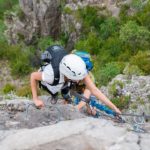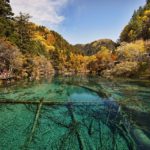We spent a day hiking in Aigüestortes National Park across a wild landscape of twisting waters and soaring summits in the Catalan Pyrenees
Tucked away in the northwestern corner of Catalonia, deep in the Catalan Pyrenees, is the region’s best-kept secret: Aigüestortes and Lake Sant Maurici National Park or Parc Nacional d’Aigüestortes i Estany de Sant Maurici in Catalan.
Aigüestortes is absurdly pretty. Mighty jagged peaks tower far above evergreen forests and myriad glinting lakes. It’s a landscape begging to be hiked – and so we did.
At 141 km sq, Aigüestortes is relatively small for a national park. Extending 20km east to west, and just 9km north to south, it is one of 14 national parks in Spain, but the only one in Catalonia.

With national park status comes extensive protection. On arrival at the park, visitors are handed a set of rules written in five languages. Hunting, fishing, camping, fires, swimming, off-road cycling and all motorised vehicles are strictly forbidden within its boundaries.
It may sound prohibitive, but the end justifies the means. Aigüestortes is one of the most peaceful place we’ve ever seen.
It’s easy to see where the park gets its name – which roughly translates as ‘twisted waters and St. Maurice Lake’. Everywhere you look in this wild Pyrenean landscape, water greets your gaze. A slew of streams trickle down the mountainsides where they course into waterfalls that feed the park’s 200-plus lakes.
The waters teem with trout and provide ample habitat for the many frogs, toads and Pyrenean newts that live in the resultant wetlands. Along the lakeshore, muskrats and otters roam also.
Soaring summits – four of which top 3,000m with a further 10 over 2,800m high – surround the sparkling lakes. The most famous peaks are the Els Encantats (enchanted) pinnacles of Gran Encantat at 2,748m (9,016ft) and El Petit Encantat at 2,734m (8,970ft). They provide one of the region’s most recognisable images and are even used in the park’s official logo.
The steep slopes are home to wild goats and marmots, while cattle shod with cowbells graze the lush, rolling pastures. The scene is utterly idyllic.
The park has two main entrances. One is located in the west, 10km from the visitor centre in the village of Boí. The second is at Estany de Sant Maurici, 8km from the visitor centre at Espot. As cars are not allowed in the park, 4WD taxis run visitors between the two villages and the trailheads.

We began our hike at the western end of the park at the trailhead of Carretera d’Aigüestortes a l’Estany de Sant. We hiked eastwards along the trail to Estany de Sant Maurici (Sant Maurici Lake), a distance of around 10km.
The route began obligingly enough, meandering along boardwalks and crisscrossing streams beneath a shaded forest. This is the most popular area of the park with many visitors content with spending an hour or two strolling the pathways before returning to the Vall de Boí. We, of course, continued.
It took around an hour and a half to reach Estany Llong, a popular lake and picturesque picnicking spot. A steady line of walkers and families spread themselves along the lakeshore to enjoy the divine view. There was ample shoreline to go around and as swimming is off-limits the area retains its peaceful ambiance.
It’s here that most day-trippers will about turn and return to where they started as the onward trail begins to ascend. Our climb was gentle at first, but soon became more challenging. The higher we got, the better the views. Eventually, just as the upward march began to dispirit, the trail reached its peak at Portarró d’Espot: a high pass with striking vistas in every direction.

Looking back to the west was Estany Llong and forward to the east was Estany de Sant Maurici with the twin peaks of Els Encantats standing guard. The sun was strong with barely a cloud in the cerulean sky and other than a herd of lackadaisical cows, we had the pass all to ourselves. It was the very definition of tranquillity.
After a pause for photos, we moved on and began to descend, pausing to eat lunch high above Estany de Sant Maurici. A welcome breeze was the perfect accessory to our charming picnic spot. After lunch, we snapped a final few shots before beginning our descent to the shores of Estany de Sant Maurici.
At the end of the trail, we waited in line with a handful of tourists for the 4WD taxis to Espot, where all of a sudden it was over and we were back in civilisation and there were no cows but cars, shops and phone reception instead.
Hiking in Aigüestortes National Park among its ‘twisted waters’ is a complete escape from the world. It’s everything that hiking should be. The park may well be small, but it feels a million miles from anywhere.
Atlas & BOots
Hiking in Aigüestortes National Park: the essentials
What: Hiking in Aigüestortes National Park in the Catalan Pyrenees.
- Distance: 10km
- Duration: 4-5 hours
- Elevation: 600m / 1,969ft (1,900m-2,500m)
- Difficulty: Medium
Where: We stayed at Hotel Pessets in the mountain village of Sort, a 30-minute drive from Espot at the eastern end of the park.
The 4-star hotel is modern, comfortable and perfectly situated for adventuring in the Catalan Pyrenees. The swimming pool and spa are nice touches which are certainly welcome after a day of hiking in Aigüestortes National Park.
Hotel Pessets
The hotel has several dining options including a poolside bar and al a carte restaurant, but it is the nearby Café Pessets that steals the show. As the name suggests, the café is run by the same family and serves up a delicious range of authentic tapas dishes (do not miss the chicken croquettes and if you’re veggie, ask for the beetroot version). It was the best meal we ate in Catalonia.
When: Hiking in Aigüestortes National Park can be done year round, but the best weather is from May through to the end of October. July and (particularly) August are the busiest months, so September and October appeal more. The skiing and winter mountaineering season runs from November to March.
How: We went hiking in Aigüestortes National Park with Outdoor Adventour, a local company run by charismatic CEO, Pepo, with support from a team of highly experienced guides, among them Jordi, Edu and Marc who took excellent care of us during our time in Catalonia.
Contact the team via the website, email info@outdooradventour.com or phone +34 973 043 409 / +34 654 093 295 to book activities and arrange transfers.
We flew into Barcelona–El Prat Airport (BCN), which provides easy access to the rest of Catalonia. Book flights via Skyscanner for the best prices.
































